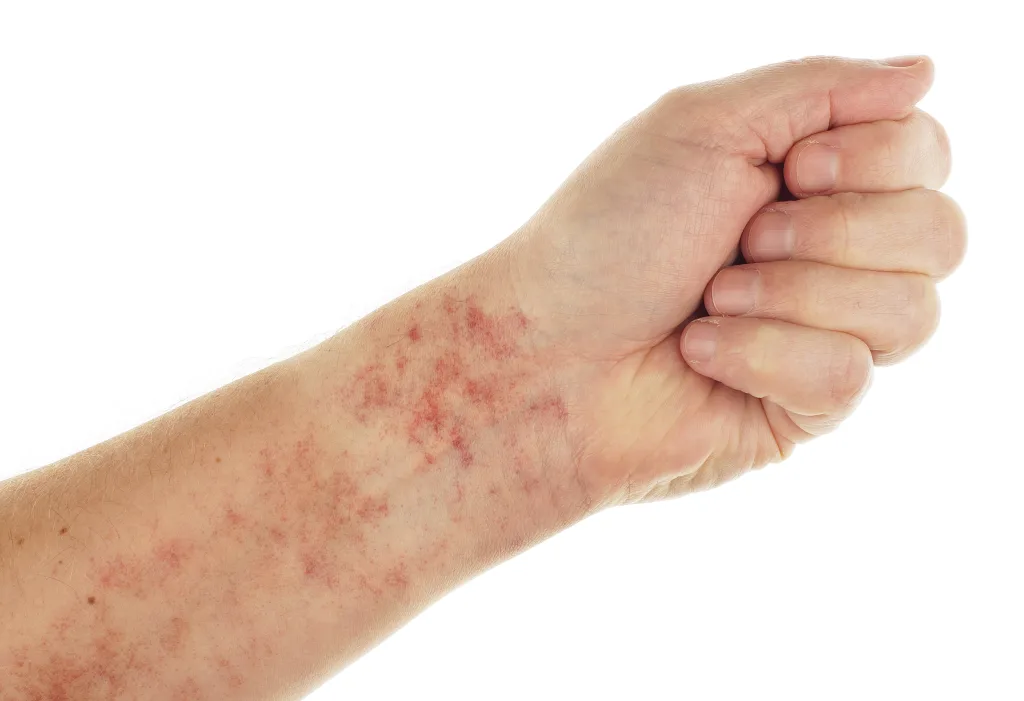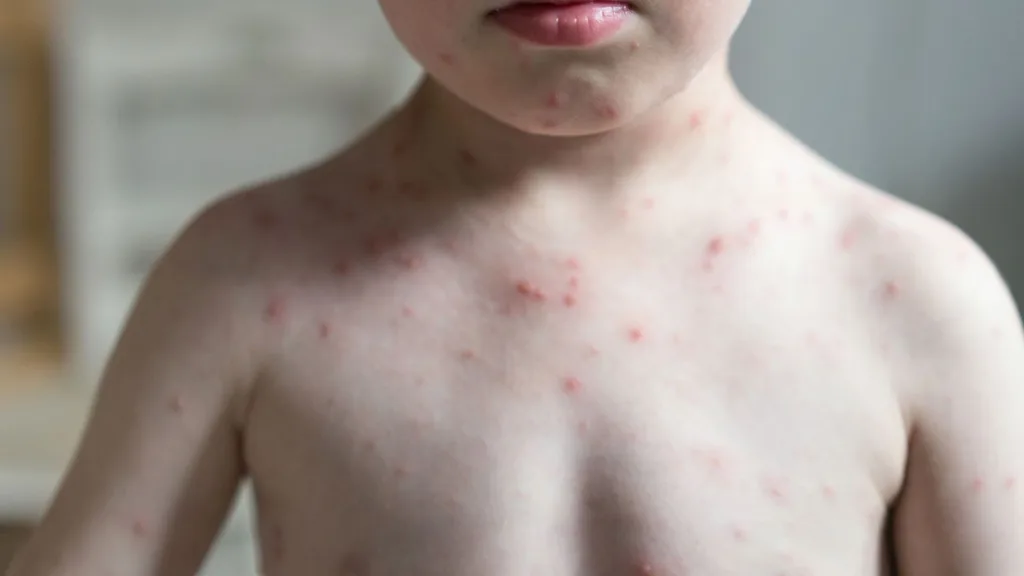Blanching of the skin is a sign of restricted blood flow to the area, causing it to become paler than the surrounding skin. The blanching test is used to check for this condition; it involves pressing down on the skin to see if redness or discoloration disappears when pressure is applied.
When performing a blanching test, gently press down on the reddened area of skin. If healthy, the red area will turn (blanch) white then return to its normal color within three seconds. Non-blanching rashes are skin lesions that do not fade when a person presses on them, and instead stay in place due to bleeding beneath the surface of the skin.
There are several possible causes of blanching of the skin, including cold temperatures and certain medical conditions such as Raynaud’s phenomenon and vasculitis. It can also be a sign of low blood pressure or an allergic reaction. If you experience blanching of your skin, it’s important to speak with your doctor so that any underlying cause can be identified and treated properly.
In addition, there are some simple measures you can take to reduce your risk of developing blanching of the skin. Keeping warm during cold weather, avoiding tight clothing or jewelry that may constrict blood flow, managing stress levels, and taking care to avoid sudden changes in temperature may all help prevent blanching episodes from occurring.
By being aware of this condition and taking appropriae steps to manage its risks where necessary, you can help ensure that your skin remains healthy and glowing for years to come!
The Meaning of Blanching on Skin
Blanching of the skin is a condition in which the blood flow to an area of the skin is restricted, resulting in the affected area becoming paler than the surrounding skin. This can be caused by a variety of conditions and should be evaluated by a doctor if you are experiencing this symptom. Blanching may appear as patches or spots of paler color on the skin, or it may appear as a large area that is uniformly pale in color. In some cases, blanching may also be accompanied by itching, swelling, or oter symptoms. Regardless of what it looks like, if you have any concerns about blanching on your skin, you should contact your doctor for further evaluation and diagnosis.

The Difference Between Blanching and Non-Blanching Skin
Blanching skin is skin that turns white or fades when pressure is applied. This occurs due to the constriction of blood vessels beneath the skin causing the blood to be pushed away from that area. Non-blanching rashes, on the other hand, do not fade or change color when pressure is applied. These rashes are often caused by bleeding underneath the skin’s surface. They may have a red, purple, or brownish appearance and may be raised, swollen or itchy. It’s important to seek medical attention if you have a non-blanching rash as they can indicate a more serious underlying condition.
Checking for Skin Blanching
Skin blanching is a test used to check for capillary refill or blood flow. It can be performed by pressing on the skin with your finger or another object for two to three seconds. If the area turns pale when pressure is applied, it indicates that there is good circulation in the area. After releasing pressure, observe how quickly the area returns to its normal color. If it takes longer than two seconds to return to normal, this may indicate poor circulation and an underlying issue such as a skin disorder or infection.
Duration of Skin Blanching
Skin blanching should last a few seconds, typically no more than 3 seconds. When you press on the reddened area of skin, it should turn white and then turn back to its original color within 3 seconds.
The Benefits of Skin Blanching
No, skin blanching is not good. Blanching of the skin occurs when the blood vessels in the area narrow and cause the skin to become pale or white. In some cases, it can indicate an underlying medical condition such as an allergy, infection, or circulatory problem. It’s important to seek medical attention if you notice any blanching of your skin because it may be a sign of an underlying health issue that needs treatment.

Appearance of Blanched Skin
Blanched skin appears whitish or pale due to the decreased blood flow to that area. This occurs in a process known as diascopy, which is a physiologic test used to examine the skin. It can also be a sign of Raynaud’s phenomenon, which is characterized by blanching of the fingers when exposed to cold temperatures.
The Causes of Blanched Skin
Blanching of the skin occurs when the body is not able to deliver enough blood to the affected area, usually due to a temporary decrease in blood flow. This can happen because of someting as simple as touching the skin, or due to more serious issues such as inflammation, poor circulation, or even an underlying medical condition. The blanching may also be caused by exposure to cold temperatures or certain medications. People with conditions like Raynaud’s disease and lupus often experience blanching of their skin when exposed to extremes in temperature. In some cases, blanching can be a sign of an allergic reaction. It is important to seek medical attention if you notice any sudden or prolonged blanching of the skin.
The Benefits of Blanchable Redness
No, blanchable redness is not good. Blanchable erythema can signal imminent tissue damage, meaning that the skin has been deprived of oxygen and nutrients due to excessive pressure. This can lead to tissue necrosis and the development of a pressure ulcer, a painful and difficult to treat wound. Therefore, it is important to take note of any blanchable redness and take action to reduce pressure in the area immediately.
The Meaning of Non-Blanchable Skin
Nonblanchable erythema is a discoloration of the skin that does not turn white when pressed. It is typically a sign of an underlying medical condition such as poor circulation, certain skin infections, inflammatory diseases, or certain forms of cancer. In some cases, it can be caused by medications or an allergic reaction. It appars as red or purple patches on the skin and can sometimes be accompanied by swelling, warmth to the touch, or pain. If nonblanchable erythema is detected on examination, further tests may be necessary to identify the underlying cause. Treatment for any associated medical conditions will depend on the cause and can include antibiotics, anti-inflammatories, or chemotherapy.
Causes of Non-Blanching Skin
Non-blanching skin rashes can be caused by a range of conditions. The most common cause is a viral illness, such as adenovirus, which causes the body to produce an excess of red blood cells in the area of the rash. Other causes include Henoch-Schonlein purpura (HSP), an autoimmune disorder; immune thrombocytopenic purpura (ITP), a condition that results in reduced platelet counts; and physical trauma or abuse. In addition, certain medications, including nonsteroidal anti-inflammatory drugs (NSAIDs) and antibiotics, can cause skin not to blanch. Finally, certain medical conditions such as Kawasaki disease can also cause skin to not blanch.
Stopping Blanching
Blanching is the whitening of the skin due to a lack of blood circulation. To stop blanching, it’s important to get your circulation back up and running. To do this, start by massaging the affected area with gentle strokes. This helps to break up any blockages that may be preventing blood flow. Additionally, you should do regular stretches and exercises that are designed to improve blood flow in your limbs. If you’re able to, try ding some light aerobic activity such as walking or swimming. Finally, make sure you’re eating a healthy diet full of fruits and vegetables, as these can help improve your circulation as well.
Conclusion
In conclusion, blanching of the skin is a sign of restricted blood flow to an area of the skin, causing it to become paler than its surrounding area. Blanching rashes fade or turn white when pressure is applied and can be tested by gently pressing down on the affected area. If the area turns white before returning to its normal color, this may indicate blanching. It is important to consult your doctor if you believe that you may have a condition causing blanching of the skin.
